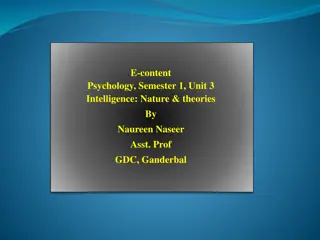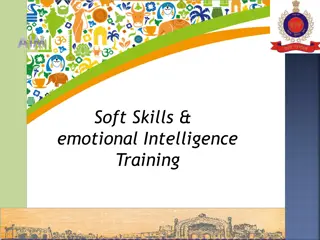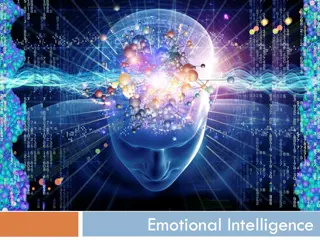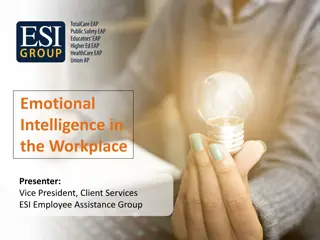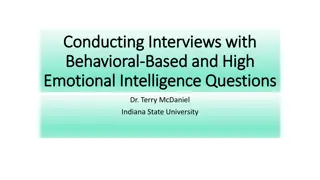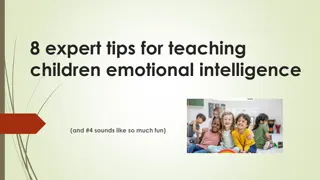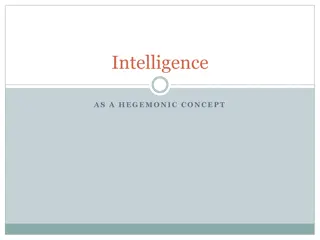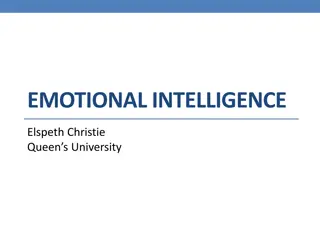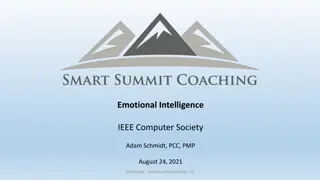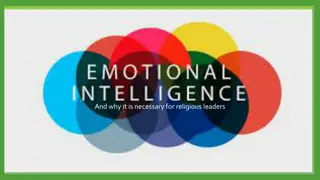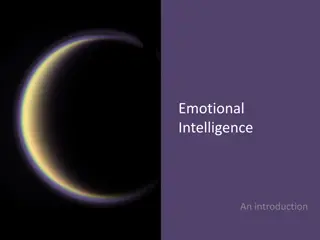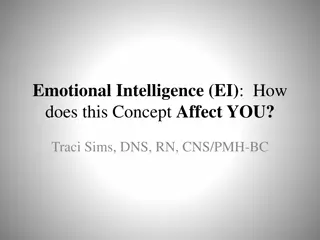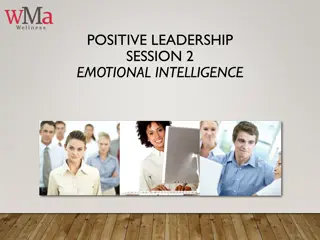Understanding Emotional Intelligence: Key Principles and Skills
Emotional intelligence, as presented by David Taylor, is crucial in perceiving, understanding, and managing emotions in oneself and others. It plays a vital role in professional and personal relationships by enhancing emotional awareness, recognition, and management. The principles of emotional intelligence involve being aware of emotions and effectively using and managing them. The skills include identifying and understanding emotions, recognizing nonverbal cues, and navigating emotional dynamics. Developing emotional intelligence leads to better communication, empathy, and social interactions.
Download Presentation

Please find below an Image/Link to download the presentation.
The content on the website is provided AS IS for your information and personal use only. It may not be sold, licensed, or shared on other websites without obtaining consent from the author. Download presentation by click this link. If you encounter any issues during the download, it is possible that the publisher has removed the file from their server.
E N D
Presentation Transcript
Emotional Intelligence Presented by David Taylor Businet General Manager
When dealing with people, remember you are not dealing with creatures of logic, but creatures of emotion - Dale Carnegie
- Emotions are what drive us and emotions can also lead us astray - In Latin, emotions are described as motus anima, meaning the spirit that moves us
No matter how logical, reasonable and rational we think we are, it is our emotions that motivate and propel us. Emotions play a key part in the way we perceive, understand and reason about people and things.
Emotional intelligence involves a set of skills that defines how effectively you perceive, understand, use and manage your own and others feelings. It is the most important factor in how well you get on with others professionally as well as personally.
Emotional intelligence can be seen as having two key principles 1. Being aware of emotions (your own and other people s emotions) 2. Using and managing emotions
Identifying emotions Being able to name or describe an emotion Recognizing emotions in nonverbal communication and behaviour, facial expression, tone of voice and body language Recognizing how clear, typial, influential or reasonable a particular emotion is Being able to recognise appropriate and inappropriate expression of emotion
Understanding emotions Making sense and meaning about emotions Any one aspect (physical, cognitive or behavioural) of an emotion can affect another Being aware of the differences, transition, variations and degrees of intensity between emotions Understanding for example the difference between anger, frustration, disappointment and regret Ability to understand how and why you and other people experience certain emotions in certain situations Understand the impact on social dynamics Understand emotions includes knowing when and how emotive language and behaviour is being used
Using emotions The ability to draw on emotions to help and inform your thinking, reasoning and problem solving Using your intuition Using emotions to help make decisions about what to do and not to do Prioritise thinking and behaviour Knowing how to use emotions to build empathy and rapport with others
Using emotions Using emotions also includes knowing how to draw on emotions to create specific moods Knowing when sad emotions can be induced, for example with the use of sad music at a funeral
Managing emotions Ability to manage your own and other people s emotions, according to specific goals and whatever is deemed appropriate in the circumstances, a particular situation or context Unlike controlling emotions, this does not mean dominating or suppressing emotions Managing emotions involves handling emotions with a degree of skill and flexibility
Emotional intelligence identifying and understanding, using and managing emotions is a dynamic process; each ability influencing the other Self- awareness Other people management Other people awareness Self management
Reflect. Reflect, and then Reflect again! businet.org.uk businet@gmx.com
Reflection: Serious thought or consideration. - Oxford English Dictionary businet.org.uk businet@gmx.com
What is Reflective Practice? Reflective practice is, in its simplest form, thinking about or reflecting on what you do. It is closely linked to the concept of learning from experience, in that you think about what you did, and what happened, and decide from that what you would do differently next time. businet.org.uk businet@gmx.com
The difference between casual thinking and reflective practice is that reflective practice requires a conscious effort to think about events, and develop insights into them. Once you get into the habit of using reflective practice, you will probably find it useful both at work and at home. businet.org.uk businet@gmx.com
Reflective practice is an active, dynamic action-based and ethical set of skills, placed in real time and dealing with real, complex and difficult situations. Moon, J. (1999), Reflection in Learning and Professional Development: Theory and Practice. businet.org.uk businet@gmx.com
Developing and Using Reflective Practice What can be done to help develop the critical, constructive and creative thinking that is necessary for reflective practice? businet.org.uk businet@gmx.com
Neil Thompson, in his book People Skills, suggests that there are six steps: Read - around the topics you are learning about or want to learn about and develop Ask - others about the way they do things and why Watch - what is going on around you
Feel - pay attention to your emotions, what prompts them, and how you deal with negative ones Talk - share your views and experiences with others in your organisation Think - learn to value time spent thinking about your work
Reflective practice is a tool for improving your learning both as a student and in relation to your work and life experiences. Although it will take time to adopt the technique of reflective practice, it will ultimately save you time and energy.



